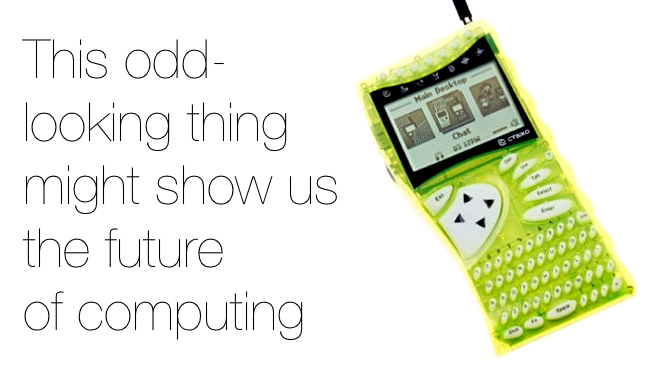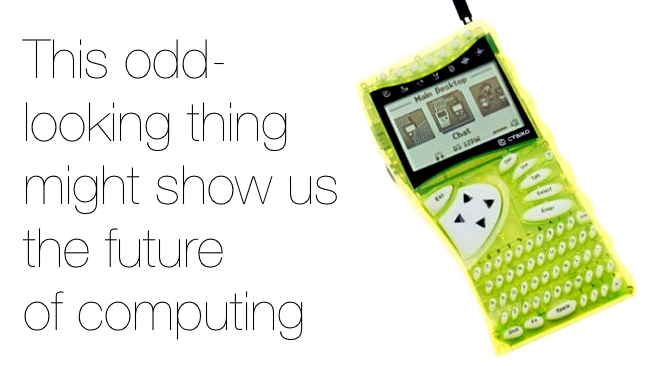
 Cybiko games console
Cybiko games console
The technology revolution that's taking place around us is so massive that it's difficult to get a perspective on it. Some aspects of technology are not just doubling or trebling every ten years but improving by factors of 100 or 1000
And that's just individual fields of research, manufacture and development.
But what happens when you put several threads of technology together, and see how they interact?
This is, of course, happening all the time. If you take a single circuit board, like the main board in a smartphone, you'll see a bewildering number of technologies that have had quite distinct development paths. Satellite navigation, nanotechnology (in the accelerometers and gyroscopes), wireless communication and computing power. You could get much more fine-grained than this, but almost no matter how deep you go, you'll find some other aspect of technology that was separately researched, developed, and integrated with the rest of the components.
And then there's software, which sits above the hardware, orchestrating the way it works - glueing together the disparate parts.
We do appear to be in a race, where the individual participants not only run as fast as they can, but they help - and are helped by - the other competitors.
What would happen if it all stopped?
But what happens when the race stops? What if through some natural or man-made disaster we couldn't develop our hardware any further? Would this mean the end of civilisation as we know it, or would it just mean that we grow old with our 4th generation iPads?
Actually it would mean neither of these.
Because what would happen is that we would realise that we have only just begun to extract the full performance from the equipment we already own.
You can see examples all over the place. Look at the way Magic Lantern has turned the five year old EOS 50D, which was never meant to capture video, into a high quality digital cinematography tool (albeit with some pretty severe disadvantages).
Software can bring out features that were never there before. We've all used to expecting software updates that increase the abilities of the things we own.
Of course, there's a limit to how much you can upgrade an individual item. But there's almost no limit to what you can do if you connect them all together.
Cybiko
In the very early parts of the last decade, there was a handheld games console called Cybiko. It wasn't the most powerful of devices, with, but it had two processors, one running at 11MHz and the other at 4MHz. But what made this Russian-made toy much more powerful than its feeble hardware would suggest is that it had a built-in wireless mesh networking system. Put a bunch of Cybiko owners together in the same place and they could text each other and play collaborative games. At one point, apparently, there were enough of these things in New York that you could text co-owners almost anywhere in the city because the signals would hop from device to device.
Fast-forward to today, and you have handheld devices that make Cybikos look like iron-age tools in comparison. Full HD screens, 4G wireless connectivity, and very powerful mobile processors. All in your pocket so that you can take them everywhere.
Now, imagine that you're in a sports stadium. The chances are that you have around 40,000 smartphone owners there. Let's assume that a smartphone is typically a tenth as powerful as a desktop computer (on average, this is probably an underestimate).
What the Cybiko could do that - frankly, surprisingly - smartphones can't is set up a mesh network. There's no reason they shouldn't do this because the technology is well established, but you can imagine that the network operators wouldn't be massively happy if all of their voice and data traffic suddenly went "off piste".
What if they could?
But just imagine for a minute that they could. What you'd have is a distributed network of smartphones that would be as powerful as 4,000 desktop computers. That's a sizable computing resource.
Software is getting better and better at running on different types of hardware. It's called "virtualisation". There are some losses in translating between the platform that the software "thinks" its running on and the actual hardware, but it only takes another generation of hardware evolution to wipe out that disadvantage.
So, we are poised at a threshold where virtually all of our computing devices can work together, giving us massive distributed processing power. All we need is for people to give permission for it to happen.
There is untapped greatness in our existing computer hardware. And it's actually the perfect time for this change to take place.
The Cloud
Cloud computing is an unbelievably "buzzy" word at the moment - even more so than 4K!. If you're a company exhibiting at a trade show, you 'd better have some kind of Cloud offering! Aside from its use as a marketing buzzword, the Cloud is here to stay, and what better way to speed it up and make it "intelligent" than to have cloud-based smartphone processing?
The reality is that there are all sorts of questions to be answered before this could happen. Who would have the right to use your phone? Would you get paid for it? How would you know that someone wasn't using your phone for nefarious purposes?
It's not just smartphones that could take part in this processing grid. Pretty soon our houses will be festooned with connected processing devices. In fact the number of these is likely to rise exponentially.
Think this will never happen? Have a look at the press release on the next page.
New app puts idle smartphones to work for science
By Robert Sanders, Media Relations | July 22, 2013
BERKELEY -
Android smartphone users will soon have a chance to participate in important scientific research every time they charge their phones. Using a new app created by researchers at UC Berkeley, users will be able to donate a phone's idle computing power to crunch numbers for projects that could lead to breakthroughs ranging from novel medical therapies to the discovery of new stars.
BOINC logo
A new Android app called BOINC allows smartphone users to contribute their phone's processing power to scientific research.
The app was created by a Berkeley project called BOINC (Berkeley Open Infrastructure for Network Computing), which is known for its computer software that supports more than 50 volunteer computing projects around the world. BOINC software allows projects to tap unused processing power donated by computer owners around the world to analyze data or run simulations that would normally require cost-prohibitive supercomputers.
The new Android app, also called BOINC, will be available Monday, July 22, from the Google Play Store and works on Android versions 2.3 or later. The app currently supports several popular computing projects, including Einstein@Home, which searches radio telescope data for spinning stars called pulsars, and FightAIDS@Home, which searches for more effective AIDS therapies as part of IBM's World Community Grid. Android, owned by Google Inc., is the operating system used by two-thirds of all smartphones today.
"There are about a billion Android devices right now, and their total computing power exceeds that of the largest conventional supercomputers," said BOINC creator David Anderson, a research scientist at UC Berkeley's Space Sciences Laboratory. "Mobile devices are the wave of the future in many ways, including the raw computing power they can provide to solve computationally difficult problems."
Creation of the app was funded by the Max Planck Institute, which runs Einstein@Home; Google Inc.; and the National Science Foundation, which has supported BOINC since 2002. IBM assisted in the design of the user interface and organized beta testing of the app.
Sign up for Einstein@home and search for spinning stars called pulsars using the new BOINC app.
"Our main goals are to make it easy for scientists to use BOINC to create volunteer computing projects to further their research, and to make it easier for volunteers to participate," Anderson said.
Anderson noted that the app will run only when the phone is plugged in and charging and after the battery is more than 95 percent charged, since computing can slow the recharge rate. It will only communicate with computing projects through the Internet when connected via WiFi, to avoid burning through users' data plans. These default settings can be customized by users, however.
Other projects now available through the BOINC app are Asteroids@home, operated by Charles University in Prague; OProject@Home; and Yoyo@home.
Among the projects slated to be adapted to the Android BOINC app is the first and most successful volunteer computing project, UC Berkeley's SETI@home, which analyzes radio telescope data in search of intelligent signals from space.
Owners of iPhones should stay tuned. A BOINC app for Apple products like iPhone and iPad may be Anderson's next project.
Tags: Technology


Comments